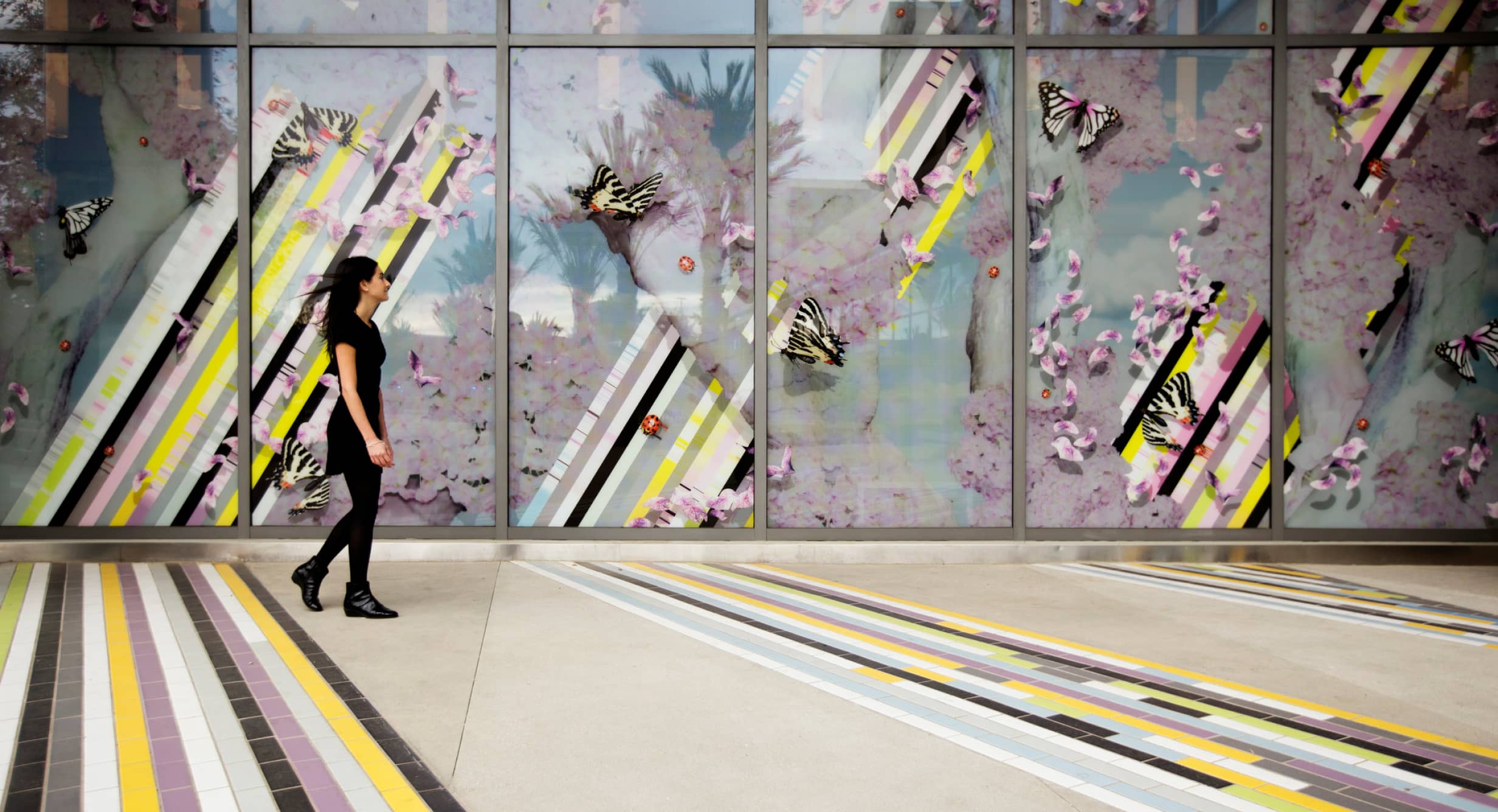
Advancing Mental Health Care Through Design: Common Ground from Uncommon Conversations
- Ashleigh Cotter
- Rachael Farrell
- Nathan Howell
- Jeff Kabat
- Hannah Shultz
Lauren Kennedy West remembers. She remembers being brought in handcuffs from her psychiatrist’s office and restrained to a metal gurney alone, stripped naked and visible to other patients. The trauma happened to her when she was hospitalized during a mental health crisis.
West relayed this story in a keynote address to a two-day Mental and Behavioral Health Think Tank hosted by the HKS Health practice earlier this year. HKS invited West, a Canadian social worker and creator of the popular YouTube channel Living Well with Schizophrenia, to share her insights on the mental health system with our team of researchers, medical planners and designers and a diverse array of mental health stakeholders. We gathered the group of more than 20 experts in education, health care, the judicial system, and nonprofits that serve people experiencing homelessness to learn about the state of the mental health system and brainstorm strategies for improvement.
As West and other Think Tank participants made clear, the mental and behavioral health system in its current form is broken. We heard a common theme in her story and that of others that there is a lack of community understanding about mental health and a lack of connection that contributes to stigmas in various forms. This is in addition to a system that is difficult to navigate and rife with obstacles to accessing care, funding and reimbursement.
West said her terrifying hospital ordeal intensified one of her symptoms – a distrust of the medical system – but a compassionate nurse regained her trust and helped put her on a path to improved health and well-being. Her story illustrates how environments for care deeply impact how people feel about themselves and the competence and consideration of their care team moving forward.
Promising Practices
Three major themes arose from our Think Tank conversations:
- Commonplace Resiliency – Strategies to increase mental health resiliency should be built into the greater fabric of our communities, to support prevention and early intervention.
- Empowering Self-Advocacy – Patients should feel empowered in their right to seek out a care model that supports their personal health and wellness goals.
- Seeing the Whole Person – Effective treatment strategies employ person-centered care, which requires fully understanding physical, mental, and socioeconomic factors, not just responding to symptoms at the onset of a crisis.
Design can play a key role in all three themes. By creating welcoming spaces throughout the community to provide a full spectrum of mental and behavioral health care services, designers can help build connections between people, empower patients to choose care paths that meet their needs and advance innovative care.
Commonplace Resiliency
Como Community Center is a bright, cheerful, light-filled building where residents of Fort Worth’s Como neighborhood gather to talk, play, nurture friendships and uphold neighborhood traditions. Establishing touchpoints for mental and behavioral health in buildings like this – including schools, libraries, community centers and clinics – could substantially support public health and strengthen social connections. Making environments for mental and behavioral health care more commonplace could help reduce the associated stigma, generating instead a more universal sense of belonging. It would also help distribute resources to a wider array of individuals, families and concerned community members, so that they can advocate more successfully for themselves and people they care about.
Regardless of where people are on their personal journey to mental health and well-being, a warm, familiar environment can help put them at ease and encourage them to be more receptive to care. Acoustical surfaces and softer materials create a calming effect, and the strategic use of textural features can provide a soothing sensory experience for some individuals. Culturally relevant details are meaningful to achieving a friendly, empathetic atmosphere conducive to advancing mental and behavioral health care.

Biophilic design leverages the innate human connection to the natural world to promote health and well-being. Biophilic design principles include soft natural forms, greenery, daylight, views and access to courtyards, natural materials such as wood and stone, and color palettes, patterns and artwork inspired by nature. INTEGRIS Arcadia Trails Center for Addiction Recovery in Edmond, Oklahoma, for example, features warm natural wood and stone to provide a homelike atmosphere. Daylight and nature imagery bring a sense of peace to Zev Yaroslavsky Family Support Center, a Los Angeles center for counseling, child support, mental health and public health services.
Color theory demonstrates that certain colors evoke certain emotions. Pops of bright color, generally without deep gray or black undertones, enliven a space and appear happy. Neutral backgrounds can allow individuals to personalize a space through artwork, different lighting hues and similar colorful design elements. Spaces that allow for personalization, choice and control over one’s environment help uphold individual dignity and promote autonomy.

Empowering Self-Advocacy
The right to refuse treatment can be a barrier to healing. Empowering self-advocacy and ownership of care leads to greater success in the realization of personal health goals. West and other experts at the Think Tank noted that patients often feel powerless in directing their care; however, gaining a sense of control is essential to healing. Based on her experience, West advocates for correcting the power imbalance between patients and caregivers to enable people to “take the helm” of their own care journey.
By offering seating options, variable lighting, places to decompress, opportunities to engage in a variety of activities or differing degrees of social interaction, designs can help foster a sense of empowerment. This is demonstrated in the design of Smithfield Elementary School in North Richland Hills, Texas, where zones for activity, play and respite empower students to discover, play and take breaks according to their individual comfort levels. The Sensory Well-Being Hub at Lane Tech College Prep High School in Chicago provides a range of soothing and lively activities to allow students to calm down and refocus on their own terms.
Designing flexible spaces for mental and behavioral health care into education facilities could aid in early intervention and help prevent mental health issues from escalating. School design should consider how to enable strategies to increase mental health equity and connect students and families to support, such as incorporating mandatory counselling as part of the grade school experience and integrating mental health first aid into the regular curriculum.
Integrating the health care campus into the broader community would help create an extended support network to ease challenges to navigating the care continuum. Environments of care within this extended network might include, for example, resource centers to assist parents and other caregivers in understanding their loved one’s condition and determining when to seek help.
The design of hospitals, pediatric health centers and primary care clinics can support patients, families and caregivers by incorporating flex space that can be used for individual or group care, professional development or family health education, such as instruction on how to care for a child with mental health needs. Nurse stations designed to promote interactions between caregivers and patients can lay the groundwork for trusting relationships. Comfortable places for grief or respite provide health care staff and family members spaces to retreat and recharge, so that they may continue to nurture others.
Seeing the Whole Person
West said her care journey has included a misdiagnosis, hurried triage, lack of follow-up care, side effects of medication and agonizing relapses. A disjointed care plan that responded primarily to crises let her down repeatedly. Treatment that fails to see the whole person is ineffective. Environments of care must consider the complete physical, mental and socioeconomic needs of vulnerable people.
In the geriatric community, for instance, the physical decline that accompanies aging can compound mental health issues. Supportive environments designed to promote social engagement and purpose can transform elder care.
For unsheltered individuals, access to basic needs like food, water and shelter is empowering. Spaces designed to promote relationships and supportive community can also help meet higher-level psychological needs, such as belonging and esteem. At True Worth Place, a Fort Worth day center for people experiencing homelessness, a courtyard, roof deck dining, comfortable seating options and other thoughtful design details help create a sense of community.
HKS Think Tank participant Dr. Emily Spence is Associate Dean for Community Engagement and Health Equity at the University of North Texas Health Science Center at Fort Worth. She notes that people who have been traumatized or who are experiencing other mental and behavioral health issues “are struggling with something that feels outside their control.” Environments designed to increase people’s sense of control can help build autonomy, which can have a therapeutic effect, Spence said.

According to Spence, stressful or triggering environments produce physiological reactions that can cause the logical and reasoning part of the brain to shut down. “When people are in that place, they don’t have logical reasoning abilities. If you’re offering care, their brain isn’t operating in a way that can even hear or receive it,” she said.
Environments designed to provide peace, tranquility and relief from stress “bring people to a place where they are more ready to engage in reflective dialogue,” she added. “Think about the environment as being something that is part of a person’s healing journey, because it’s giving them a sense of control.”



